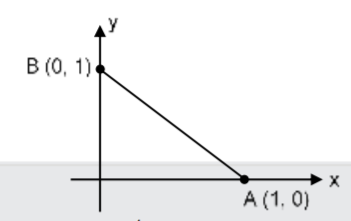Two particles start from point (2, -1), one moving two units along the line x+ y = 1 and the other 5 units along the line x - 2y = 4, If the particle move towards increasing y, then their new positions are:
The correct Answer is:(2−√2,−1+√2) and (2+2√5,−1+√5)
To find the new positions of the two particles after they move along their respective lines, we will follow these steps:
Step 1: Identify the initial position of the particles
Both particles start from the point (2, -1).
Step 2: Determine the direction and distance for the first particle
The first particle moves 2 units along the line x+y=1.
1. Find the slope of the line:
The equation x+y=1 can be rewritten as y=−x+1. The slope (m) is -1.
2. Calculate the angle:
The angle θ corresponding to this slope is given by:
tanθ=−1⟹θ=135∘ (in the second quadrant)
3. Calculate cosθ and sinθ:
cosθ=−1√2,sinθ=1√2
4. Use parametric equations to find new coordinates:
The new coordinates (x1,y1) after moving 2 units are given by:
x1=2+2⋅cosθ=2+2(−1√2)=2−√2
y1=−1+2⋅sinθ=−1+2(1√2)=−1+√2
Step 3: Determine the direction and distance for the second particle
The second particle moves 5 units along the line x−2y=4.
1. Find the slope of the line:
The equation x−2y=4 can be rewritten as y=12x−2. The slope (m) is 12.
2. Calculate the angle:
The angle θ corresponding to this slope is given by:
tanθ=12⟹θ=tan−1(12)
3. Calculate cosθ and sinθ:
Using the identity for tan:
cosθ=2√5,sinθ=1√5
4. Use parametric equations to find new coordinates:
The new coordinates (x2,y2) after moving 5 units are given by:
x2=2+5⋅cosθ=2+5(2√5)=2+2√5
y2=−1+5⋅sinθ=−1+5(1√5)=−1+√5
Final Results
The new positions of the particles are:
- First particle: (2−√2,−1+√2)
- Second particle: (2+2√5,−1+√5)
Both particles start from the point (2, -1).
The first particle moves 2 units along the line x+y=1.
The equation x+y=1 can be rewritten as y=−x+1. The slope (m) is -1.
2. Calculate the angle:
The angle θ corresponding to this slope is given by:
tanθ=−1⟹θ=135∘ (in the second quadrant)
cosθ=−1√2,sinθ=1√2
The new coordinates (x1,y1) after moving 2 units are given by:
x1=2+2⋅cosθ=2+2(−1√2)=2−√2
y1=−1+2⋅sinθ=−1+2(1√2)=−1+√2
The second particle moves 5 units along the line x−2y=4.
The equation x−2y=4 can be rewritten as y=12x−2. The slope (m) is 12.
The angle θ corresponding to this slope is given by:
tanθ=12⟹θ=tan−1(12)
Using the identity for tan:
cosθ=2√5,sinθ=1√5
The new coordinates (x2,y2) after moving 5 units are given by:
x2=2+5⋅cosθ=2+5(2√5)=2+2√5
y2=−1+5⋅sinθ=−1+5(1√5)=−1+√5
The new positions of the particles are:
- First particle: (2−√2,−1+√2)
- Second particle: (2+2√5,−1+√5)
Topper's Solved these Questions
- BOOK - CENGAGE ENGLISHCHAPTER - STRAIGHT LINESEXERCISE - CONCEPT APPLICATION EXERCISE 2.37videos
STRAIGHT LINES
- BOOK - CENGAGE ENGLISHCHAPTER - STRAIGHT LINESEXERCISE - CONCEPT APPLICATION EXERCISE 2.48videos
STRAIGHT LINES
- BOOK - CENGAGE ENGLISHCHAPTER - STRAIGHT LINESEXERCISE - CONCEPT APPLICATION EXERCISE 2.123videos
STRAIGHT LINES
- BOOK - CENGAGE ENGLISHCHAPTER - STRAIGHT LINEEXERCISE - Multiple Correct Answers Type8videos
STRAIGHT LINE
- BOOK - CENGAGE ENGLISHCHAPTER - THEORY OF EQUATIONSEXERCISE - JEE ADVANCED (Numerical Value Type )1videos
THEORY OF EQUATIONS
Similar Questions
Find the distance of the line 4x+7y+5=0 from the point (1,2) along the line 2x−y=0 .
View SolutionThe number of points on the linex+y=4 which are unit distance apart from the line 2x+2y=5is :
View SolutionThe coordinates of the points on the circles x2+y2=9 which are at a distance of 5 units from the line 3x+4y=25 are :
View SolutionIf a ray travelling along the line x=1 gets reflected from the line x + y = 1, then the eqaution the line along which the reflected ray travels is
View SolutionThree particles start from the origin at the same time, one with a velocity v1 along the x-axis, second along the y-axis with a velocity v2 and third particle moves along the line x = y. The velocity of third particle, so that three may always lie on the same line is:
View SolutionThe triangle ABC, right angled at C, has median AD, BE and CF, AD lies along the line y=x+3, BE lies along the line y lies along the line y=2x+4. If the length of the hypotenuse is 60, fin the area of the triangle ABC (in sq units).
View SolutionA particle from the point P(√3,1) moves on the circle x2+y2=4 and after covering a quarter of the circle leaves it tangentially. The equation of a line along with the point moves after leaving the circle is
View SolutionA particle moves along the curve y=x2+2x . At what point(s) on the curve are x and y coordinates of the particle changing at the same rate?
View SolutionA particle of mass m is moving along the line y-b with constant acceleration a. The areal velocity of the position vector of the particle at time t is (u=0)
View SolutionParticle moves from point A to point B along the line shown in figure under the action of force. VecF=−xˆi+yˆj. Determine the work done on the particle by →F in moving the particle from point A to point B.
 View Solution
View Solution

